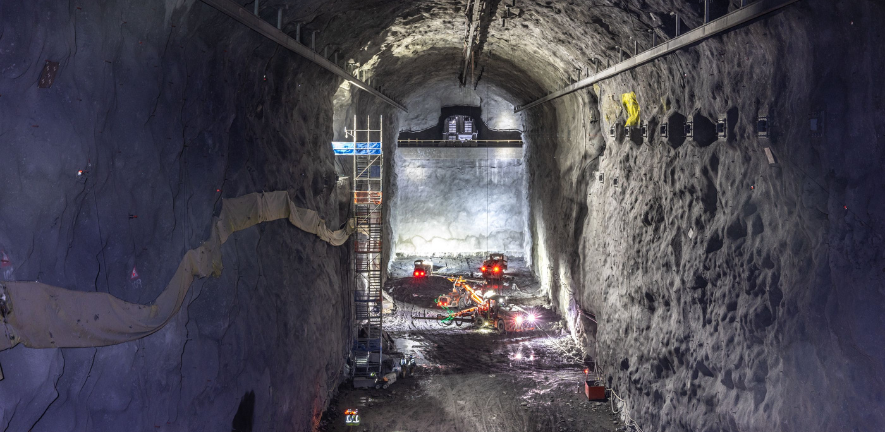
Submitted by Vanessa Bismuth on Thu, 01/02/2024 - 10:47
The excavation of the caverns that will house the gigantic particle detectors of the Deep Underground Neutrino Experiment (DUNE) in Lead, South Dakota is complete. Final outfitting of the colossal caverns will begin soon and make way for the start of the installation of the DUNE detectors later this year.
This momentous moment paves the way for our scientists to begin to answer some of the most fundamental questions of the Universe. Melissa Uchida
Excavation workers have finished carving out the future home of the gigantic particle detectors for the international Deep Underground Neutrino Experiment. Located a mile below the surface, the three colossal caverns are at the core of a new research facility that spans an underground area about the size of eight football fields.
Hosted by the U.S. Department of Energy’s Fermi National Accelerator Laboratory, DUNE scientists, including Cambridge based particle physicists, will study the behaviour of mysterious particles known as neutrinos to solve some of the biggest questions about our universe. Why is our universe composed of matter? How does an exploding star create a black hole? Are neutrinos connected to dark matter or other undiscovered particles?
The caverns provide space for four large neutrino detectors—each one about the size of a seven-story building. The detectors will be filled with liquid argon and record the rare interaction of neutrinos with the transparent liquid.
Trillions of neutrinos travel through our bodies each second without us even knowing it. With DUNE, scientists will look for neutrinos from exploding stars and examine the behaviour of a beam of neutrinos produced at Fermilab, located near Chicago, about 800 miles east of the underground caverns. The beam, produced by the world’s most intense neutrino source, will travel straight through earth and rock from Fermilab to the DUNE detectors in South Dakota. No tunnel is necessary for the neutrinos’ path.
The Cambridge DUNE group based at the Cavendish Laboratory has been actively involved in the international project since its inception, working across hardware, software, calibration and analysis.
“We are very excited to have reached this milestone,” said Dr Melissa Uchida, lead of the Cambridge DUNE group and Associate Professor of Particle Physics at the Cavendish Laboratory. “The completion of the cavern will allow us to begin the assembly of the main detectors, laboratories and infrastructure needed to make this incredible experiment a reality.
“This momentous moment paves the way for our scientists to begin to answer some of the most fundamental questions of the Universe, for example to determine if neutrinos partly responsible for the existence of our matter dominated Universe."
Engineering, construction and excavation teams have been working 4,850 feet below the surface since 2021 at the Sanford Underground Research Facility, home of the South Dakota portion of DUNE. Construction crews dismantled heavy mining equipment and, piece by piece, transported it underground using an existing shaft. Underground, workers reassembled the equipment, and workers spent almost two years blasting and removing rock. Close to 800,000 tons of rock were excavated and transported from underground into an expansive former mining area above ground known as the Open Cut.
Workers will soon begin to outfit the caverns with the systems needed for the installation of the DUNE detectors and the daily operations of the research facility. Later this year, the project team plans to begin the installation of the insulated steel structure that will hold the first neutrino detector. The goal is to have the first detector operational before the end of 2028.
DUNE scientists are eager to start the installation of the particle detectors. The DUNE collaboration, which includes more than 1,400 scientists and engineers from over 200 institutions in 36 countries, has successfully tested the technology and assembly process for the first detector. Mass production of its components has begun. Testing of the technologies underlying both detectors is underway using particle beams at the European laboratory CERN.
Adapted from a Fermilab press release
Image:
A bird’s eye view of one of the large caverns, about the height of a seven-story building. Detectors will be placed here to study the behavior of neutrinos. The DUNE detectors in SD are expected to be the largest underground cryogenic system in the world.
Credit: Matthew Kapust, Sanford Underground Research Facility
